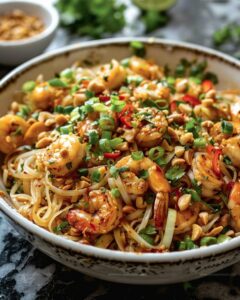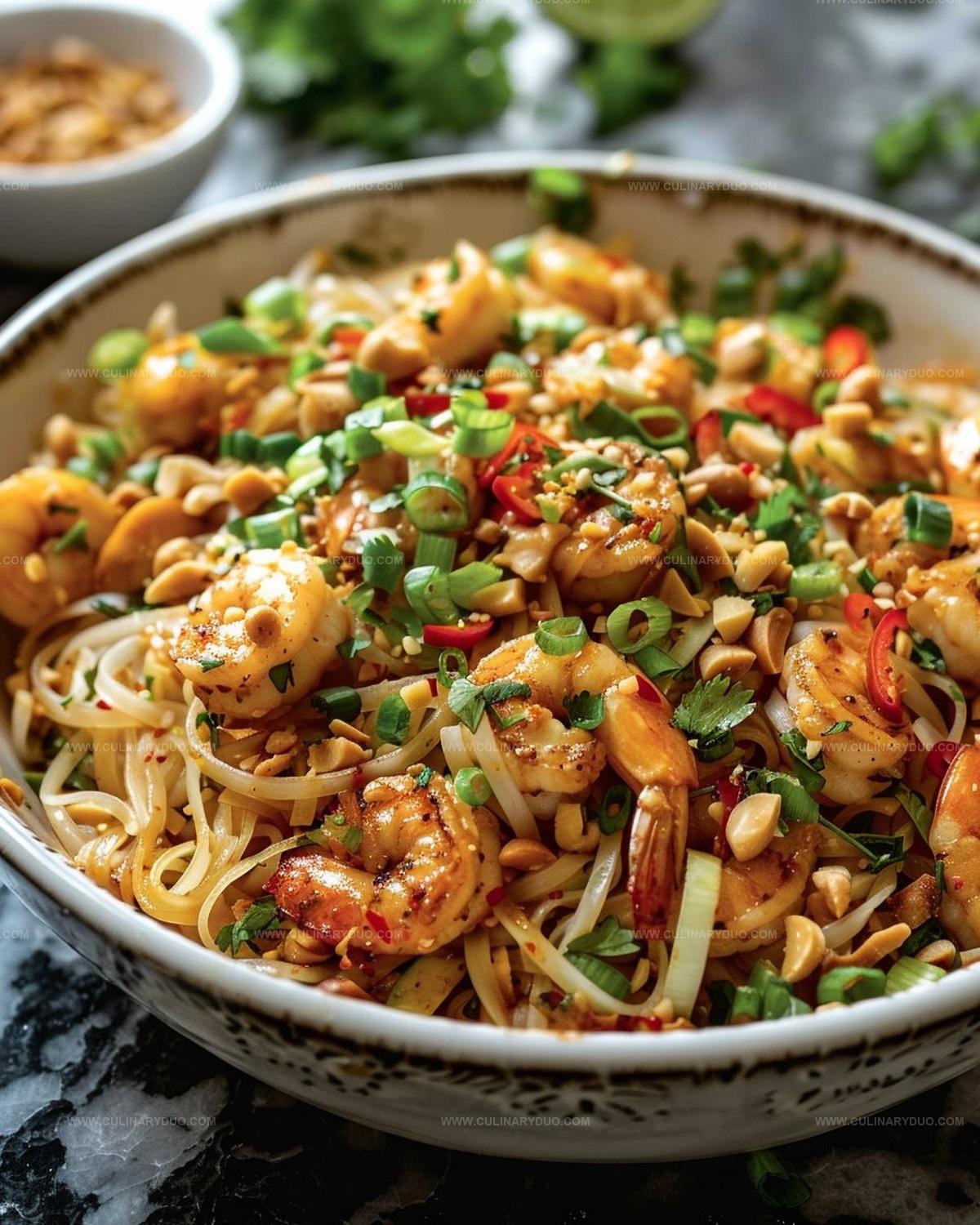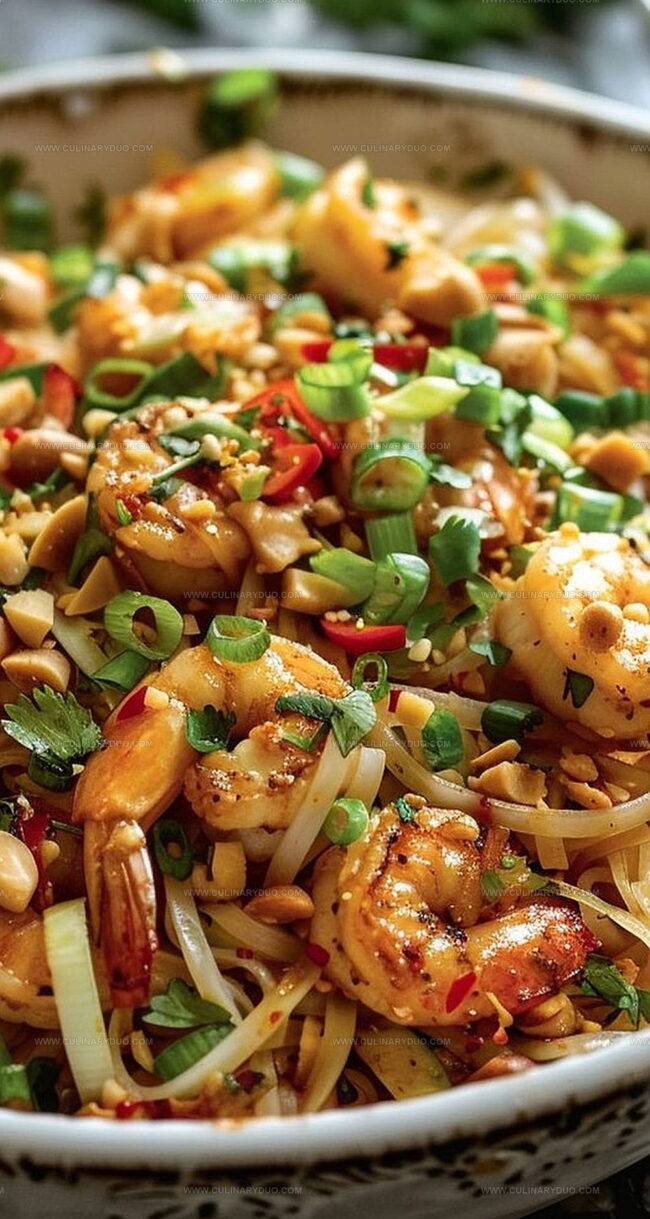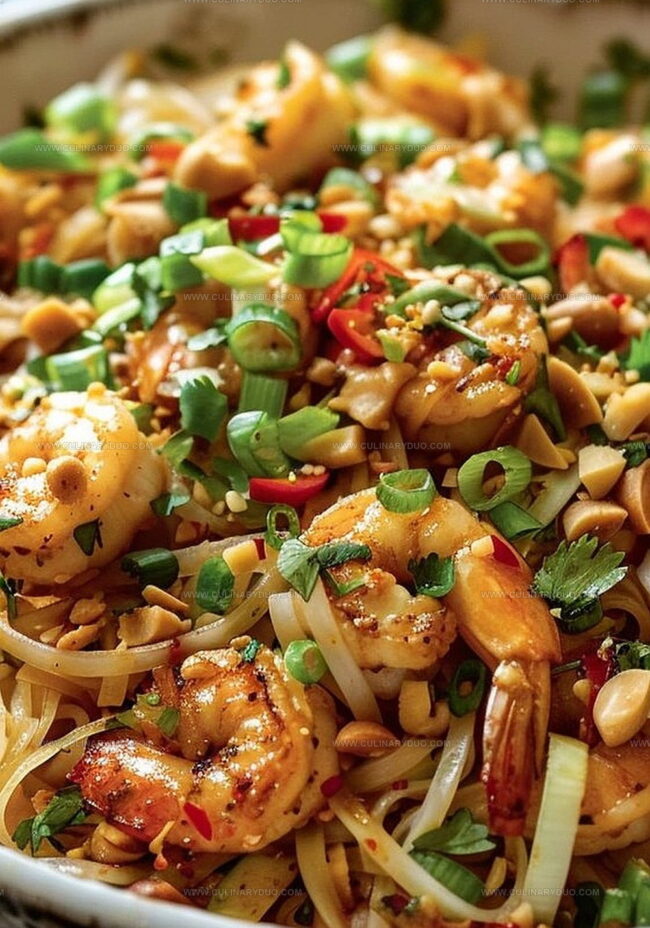Quick & Zesty Pad Thai Recipe: A Taste of Thai Magic at Home
Tangy, vibrant pad thai bursts with authentic Thai street food flavors that dance across your palate.
This classic noodle dish combines delicate rice noodles with zesty tamarind sauce for an unforgettable culinary experience.
Tender shrimp or chicken intermingle with crunchy bean sprouts and perfectly scrambled eggs.
Toasted peanuts add a delightful nutty crunch that completes each mouthwatering bite.
The balanced blend of sweet, sour, and savory notes makes this recipe a true crowd-pleaser.
Restaurants charge premium prices, but you can easily recreate this restaurant-quality meal in your own kitchen.
Unlock the secrets of this beloved Thai classic and transform your dinner into a celebration of bold, irresistible flavors.
Why Pad Thai Is a Timeless Favorite
Ingredients for Classic Pad Thai
Main Protein:Noodles:Vegetables and Aromatics:Sauce Ingredients:Eggs:Crunchy Toppings:Garnish:How to Make Authentic Pad Thai
Step 1: Prepare Noodles
Cook rice noodles according to package instructions until they’re just tender.
Quickly rinse the noodles under cold water to stop the cooking process and prevent sticking.
Step 2: Create Flavor-Packed Sauce
In a small bowl, blend together fish sauce, tamarind paste, sugar, and rice vinegar.
Stir until the sugar dissolves completely, creating a tangy and sweet sauce that’ll make your taste buds dance.
Step 3: Sizzle Protein and Veggies
Heat oil in a large wok or skillet over medium-high heat.
Add your choice of protein:Toss in minced garlic and colorful bell peppers.
Cook shrimp until they turn pink and curl up, about 1-2 minutes per side.
For chicken, ensure it’s fully cooked through, about 3-4 minutes.
Step 4: Scramble Fluffy Eggs
Push the protein and veggies to one side of the pan.
Crack eggs into the empty space and scramble them, breaking into small, fluffy pieces with a spatula.
Step 5: Combine and Toss
Add the prepared noodles, sauce, and these crunchy ingredients:Toss everything together, ensuring each noodle gets coated with the delicious sauce.
Step 6: Garnish and Serve
Top your Pad Thai with:Serve immediately while hot and fresh.
Step 7: Store Leftovers
Refrigerate any remaining Pad Thai and enjoy within 2-3 days for the best flavor and texture.
Tips for Perfect Pad Thai Every Time
Flavor Variations for Pad Thai
Serving Suggestions for Pad Thai
How to Store Leftover Pad Thai
FAQs
The key ingredients are rice noodles, protein (shrimp, chicken, or tofu), eggs, bean sprouts, peanuts, and a flavorful sauce made with tamarind, fish sauce, and sugar.
Pad Thai is typically mild with a balance of sweet, sour, and savory flavors. You can add chili flakes or sriracha sauce to increase the heat level according to your preference.
Yes, simply replace the protein with tofu and use vegetarian fish sauce or soy sauce to make it completely vegetarian-friendly.
Print
Pad Thai Recipe
- Total Time: 20 minutes
- Yield: 4 1x
Description
Sizzling Pad Thai brings Bangkok street flavors straight to your kitchen with authentic noodle magic. Crisp vegetables, tender proteins, and tangy sauce create a perfect harmony that transports you to Thailand’s bustling culinary landscape.
Ingredients
Protein:
- 8 ounces (226 grams) uncooked shrimp (or chicken, or extra-firm tofu, cut into small pieces)
- 2 eggs
Noodles and Vegetables:
- 8 ounces (226 grams) flat rice noodles
- 1 cup fresh bean sprouts
- 1 red bell pepper (thinly sliced)
- 3 green onions (chopped)
- 3 cloves garlic (minced)
- 1/2 cup fresh cilantro (chopped)
Sauce and Seasonings:
- 3 tablespoons fish sauce
- 1 tablespoon low-sodium soy sauce
- 5 tablespoons light brown sugar
- 2 tablespoons rice vinegar (or tamarind paste)
- 1 tablespoon sriracha hot sauce
- 2 tablespoons creamy peanut butter (optional)
- 3 tablespoons oil
- 1/2 cup dry roasted peanuts
- 2 limes
Instructions
- Prepare rice noodles in boiling water until just al dente, approximately 3-4 minutes. Immediately rinse under cold water to halt cooking process and prevent sticking.
- Whisk together sauce ingredients in a separate bowl, creating a harmonious blend of flavors. Set mixture aside for later use.
- Heat oil in a large wok over medium-high heat until shimmering. Rapidly sauté protein (shrimp, chicken, or tofu) with minced garlic and sliced bell peppers for 2-3 minutes, ensuring protein is cooked through but remains tender.
- Create a well in the center of the wok and pour beaten eggs into the space. Scramble eggs using quick circular motions, breaking them into delicate pieces while maintaining a soft texture.
- Pour prepared sauce over the protein and eggs. Add soft rice noodles, crunchy bean sprouts, and roughly chopped peanuts. Toss ingredients vigorously to ensure even coating and thorough integration of flavors.
- Transfer pad thai to serving plates. Garnish generously with chopped green onions, additional crushed peanuts, fresh cilantro leaves, and zesty lime wedges for brightness.
- Refrigerate any remaining portions within 2 hours of cooking. Consume within 2-3 days for optimal taste and texture.
Notes
- Perfectly cook noodles just until al dente to prevent mushiness, avoiding overcooking which can make them soggy and break apart during stir-frying.
- Choose protein flexibility by swapping shrimp, chicken, or tofu based on dietary preferences or availability, ensuring even cooking times for each protein type.
- Control heat precisely when stir-frying to maintain ingredients’ texture and prevent burning, using medium-high heat and moving ingredients constantly for even cooking.
- Enhance flavor by toasting peanuts briefly before adding to the dish, which releases their natural oils and creates a deeper, nuttier taste profile.
- Prep Time: 10 minutes
- Cook Time: 10 minutes
- Category: Lunch, Dinner
- Method: Sautéing
- Cuisine: Thai
Nutrition
- Serving Size: 4
- Calories: 400 kcal
- Sugar: 12 g
- Sodium: 800 mg
- Fat: 20 g
- Saturated Fat: 3.5 g
- Unsaturated Fat: 15 g
- Trans Fat: 0 g
- Carbohydrates: 45 g
- Fiber: 4 g
- Protein: 22 g
- Cholesterol: 110 mg




Natalie Brooks
Co-Founder & Content Strategist
Expertise
Education
eCornell
Natalie brings the vibrant, plant-powered side to Culinary Duo. After earning her Plant-Based Nutrition Certificate from eCornell, she combined her love for fresh ingredients with a passion for storytelling, aiming to make healthy cooking simple and satisfying.
Her kitchen motto: good food doesn’t need a fancy label, it just needs fresh ideas and a little creativity. Outside of writing and recipe testing, Natalie’s happiest in her garden, exploring farmers’ markets, or mixing global flavors into new kitchen experiments.